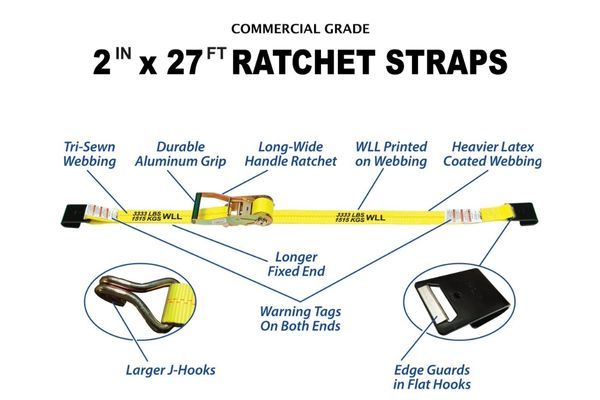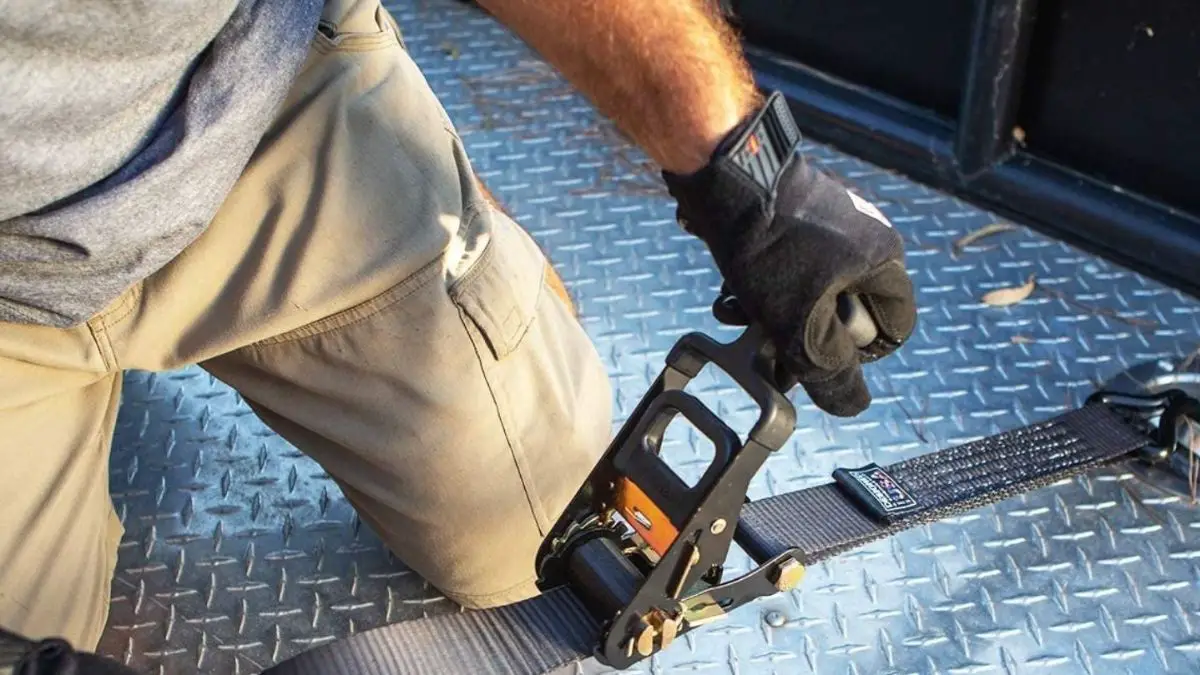Ratchet straps are versatile tools that can be used for loosening, releasing, and securing cargo. In this post, we’ll discuss the different ways to use a ratchet strap and provide some tips on how to get the most out of this handy tool.
Let’s dive in!
What is a Ratchet Strap & What is it Used For?

Ratchet straps (also known as cargo straps) are long straps made of tough material, like nylon, with a ratchet-type mechanism built into one end.
This mechanism allows you to easily tighten the strap around whatever heavy duty cargo you’re trying to secure, whether a load of lumber on a trailer or a motorcycle on a tow truck.
Once the strap is tightened, the ratchet mechanism locks in place, keeping the strap tight and ensuring that whatever you carry stays put.
Ratchet straps are an essential part of many different types of work and activities, from hauling construction materials to tying down equipment for a cross-country move.
And because they’re so strong and durable, they can be used repeatedly, making them a wise investment for anyone who does a lot of hauling.
How to Assemble a Ratchet Strap
There are many reasons you might need to use a ratchet strap. Maybe you’re securing a load on a trailer, or perhaps you’re strapping down a motorcycle or ATV.
Whatever the reason, it’s important to familiarize yourself with proper ratchet assembly so that your load is safe and secure.
Here’s a step-by-step walkthrough on how to do just that!
- Thread one end of the strap through the ratchet.
- Take the other end of the strap and thread it through the ratchet’s release lever.
- Pull the strap tight and make sure that the release lever is in the locked position.
- To secure the load, simply pull the strap tight and ratchet it until it’s snug.
- Finally, release the lever and allow the ratchet to lock into place. Your ratchet assembly is complete, and your load is now secure!
How to Release a Jammed Ratchet Strap
If your ratchet strap becomes jammed, it can be extremely frustrating. Not being able to properly secure your load can lead to all sorts of problems, not the least of which is having your load come loose and possibly causing an accident.
Fortunately, there are a few easy ways to release a jammed ratchet strap.
- Check to see if the ratchet strap is jammed or if it’s just difficult to release. If the ratchet strap is truly jammed, you’ll likely see evidence of binding or kinking in the strap. If the ratchet strap is difficult to release, it’s probably because it’s been over-tightened. In either case, you’ll need to loosen the strap to release it.
- If the ratchet strap is truly jammed, you’ll need to cut the strap to release it. Be sure to cut the strap as close to the ratchet mechanism as possible so you don’t damage it. Once the strap is cut, remove it from the ratchet and discard it.
- If the ratchet strap is just difficult to release, you can try using a lubricant such as WD-40 or lubricating oil. Spray a generous amount of lubricant onto the ratchet mechanism and let it sit for a few minutes. Then, try releasing the ratchet strap again. The lubricant should help to release the binding and allow the ratchet to function properly.
If you can’t get the ratchet strap to release using either of these methods, you’ll need to replace the strap.
Ratchet straps are relatively inexpensive, so this isn’t a huge expense. Be sure to choose a ratchet strap rated for the load limit to ensure proper safety.
How Do You Cinch Ratchet Straps?
There are a few different ways to cinch ratchet straps, depending on your type of strap- standard or cam-buckle-style.
Here’s how it’s done!
Standard Ratchet Strap
If you’re using a standard ratchet strap with a flat hook on each end, simply thread the strap through the ratchet mechanism and then back through the strap hooks.
To increase the tension, just crank the ratchet handle until the strap is tight.
Cam-Buckle-Style Ratchet Strap
If you’re using a cam-buckle-style ratchet strap, first thread the strap through the cam buckle. Then, pull the free end of the strap through the ratchet and back through the cam buckle.
To tighten, just crank the ratchet handle until the cargo strap is tight.
For both types of straps, ensure that the hooks or cam buckles are secure before cranking the ratchet. You don’t want the strap to come loose while you’re cinching it!
Frequently Asked Questions (FAQs)
What lengths do ratchet straps come in?
The most common length is 12 feet, but they can also be found in lengths of 15, 20, 25, and 30 feet. Ratchet straps are also available in shorter lengths, such as 6 and 9 feet. The choice of length depends on the weight of the load and the amount of space available.
How to ratchet strap a kayak?
First, choose a ratchet strap that is long enough to reach the entire kayak. You don’t want it to be too tight, but you also don’t want it to be too loose.
Next, attach the ratchet strap to the front and rear of the kayak. If possible, try to avoid attaching it directly to the handles or other areas that might rub against the kayak’s hull.
Finally, use a gentle ratcheting motion when tightening the strap. You don’t want to damage the kayak or the ratchet strap by over-tightening.
How to tie down a motorcycle?
To properly tie down a motorcycle, you will need two ratchet straps (or tie-downs). Ratchet straps are the best type because they are adjustable and have a locking mechanism.
Start by attaching one strap to the front of the motorcycle and threading it through the anchor point on the trailer.
Then, attach the other strap to the motorcycle’s rear and thread it through the anchor point on the trailer. Next, tighten both straps, so the motorcycle is snug against the trailer. Ensure that both straps are equally tight and that the motorcycle cannot move around on the trailer.
Finally, use the locking mechanism on each strap to secure it in place. This will help to prevent loosening during transport. With these steps, you can be confident that your motorcycle will be safely secured for transport.


